Book contents
- Frontmatter
- Contents
- Preface
- Part I The Coordinate Bethe Ansatz
- Introduction to Part I
- I The One-dimensional Bose Gas
- II The One-dimensional Heisenberg Magnet
- III The Massive Thirring Model
- IV The Hubbard Model
- Part II The Quantum Inverse Scattering Method
- Part III The Determinant Representation for Quantum Correlation Functions
- Part IV Differential Equations for Quantum Correlation Functions
- Final Conclusion
- References
- Index
Introduction to Part I
Published online by Cambridge University Press: 04 August 2010
- Frontmatter
- Contents
- Preface
- Part I The Coordinate Bethe Ansatz
- Introduction to Part I
- I The One-dimensional Bose Gas
- II The One-dimensional Heisenberg Magnet
- III The Massive Thirring Model
- IV The Hubbard Model
- Part II The Quantum Inverse Scattering Method
- Part III The Determinant Representation for Quantum Correlation Functions
- Part IV Differential Equations for Quantum Correlation Functions
- Final Conclusion
- References
- Index
Summary
A method of solution of a number of quantum field theory and statistical mechanics models in two space-time dimensions is presented in this Part. This method was first suggested by H. Bethe in 1931 and is traditionally called the Bethe Ansatz. Later on the method was developed by Hulthen, Yang and Yang, Lieb, Sutherland, Baxter, Gaudin and others (see, and).
We begin the presentation with the coordinate Bethe Ansatz not only due to historical reasons but also because of its simplicity and clarity. The multi-particle scattering matrix appears to be equal to the product of two-particle matrices for integrable models. This property of two-particle reducibility is of primary importance when constructing the Bethe wave function. The important feature of integrable models is that there is no mass-shell multiple particle production. This property is closely connected to the existence of an infinite number of conservation laws in such models; this will be clear from Part II.
Four main models, namely the one-dimensional Bose gas, the Heisenberg magnet, the massive Thirring model and the Hubbard model, are considered in Part I. Eigenfunctions of the Hamiltonians of these models are constructed. Imposing periodic boundary conditions leads to a system of equations for the permitted values of momenta. These are known as the Bethe equations. This system can also be derived from a certain variational principle, the corresponding action being called the Yang-Yang action.
- Type
- Chapter
- Information
- Publisher: Cambridge University PressPrint publication year: 1993

